
|

|
|
Home Site Search Contact Us Subscribe
|
|
Maestro, Please: Tanglewood, the summer home of the Boston Symphony Orchestra in the Berkshires, welcomes its first new facility in 25 years - to applause The Linde Center for Music and Learning, designed by William Rawn Associates Architects with Reed Hilderbrand By Kristen Richards, Hon. AIA, Hon. ASLA August 1, 2019 The landscape surrounding a soaring 100-year-old red oak tree at the top of a small hill at the Tanglewood Music Center in Lenox, Massachusetts, looks like it has been that way forever. One would never guess that the hillock had been sculpted to accommodate Tanglewood’s first new buildings in 25 years: the Linde Center for Music and Learning, designed by Boston-based William Rawn Associates Architects (WRA) with landscape design by Reed Hilderbrand.
The center is the home of the Tanglewood Learning Institute (TLI), a new programming platform for the Boston Symphony Orchestra (BSO) – the first in over 70-years – created to explore new methods and modes of cross-disciplinary programming by offering, in TLI’s words, a “diverse and daring mosaic of voices and visions.” It also provides additional concert and rehearsal space for the Tanglewood Music Center, the BSO's famed summer music academy founded in 1940 that focuses on training the next generation of musicians. (The Fellows of the Tanglewood Music Center include a young conductor named Leonard Bernstein, who was in the first class.)
There is a touch of poetic symmetry surrounding this project. Just down the hill from the Linde Center is Seiji Ozawa Hall. The 1,200-seat concert hall opened in 1994 to much acclaim by both music and architecture critics. It was the result of a two-pronged competition that resulted in a shortlist of six international star architects of the 1980s, and six young firms. To the surprise of many, Rawn and his relatively unknown firm (at the time) won. “It was like a blind audition,” William L. Rawn, III, FAIA, LEED AP, recalls. He attributes the win not to a design concept, but to the firm’s thoughtful analysis of the site.
Fast-forward to 2015, when WRA won the Linde Center commission. “We were not a sure thing,” Rawn says, “but with all our experience, there was no learning curve.” And, again, the firm’s focus was on site analysis, not a design concept. When Rawn interviewed for the project, along with WRA Principal Clifford V. Gayley, FAIA, LEED AP, they were told that the trustees had a strong preference for putting the Center behind Ozawa Hall – overlooking its loading dock – but, handily, near a parking lot.
Rawn and Gayley pointed out a problem: putting the planned programming into a 40,000-square-foot building would approach the size of and possibly overwhelm Ozawa Hall. “It had no business being the equivalent to or larger than the concert hall!” Rawn declares.
Then there was an ah-ha moment. “We walked the site with the selection committee,” Gayley explains, “and when we got to the top of the hill, we looked back and saw Ozawa Hall and the [1841 Gothic] Highwood Manor House. Suddenly the connection was the landscape – not just the proximity to the buildings.” The center continues Tanglewood’s tradition of blurring the lines between interior and exterior with flexibility and transparency established by Eliel Saarinen’s 5,700-seat Shed (1939) and Rawn’s Ozawa Hall.
Rawn attributes much of the project’s success to the unwavering commitment of Mark Volpe, the BSO's president and CEO. “We had several days of intense design sessions with Mark,” Rawn explains. “He wouldn’t even take phone calls during the design process.”
I went to Tanglewood for the Linde Center’s opening in late June – a most perfect summer’s eve. Walking the path from the parking lot to the Linde Center, with the sound of an Earth, Wind & Fire concert going on at the opposite end of Tanglewood and strains of classical music by rehearsing musicians somewhere unseen wafting through the air – I knew I’d entered a special place. After strolling past Highwood towards the Center, the first thing I noticed was that I didn’t really notice anything much beyond Ozawa Hall – and that exquisite red oak.
Then the four low-slung, discreet pavilions that make up the Linde Center appear, warm and welcoming, clad in Western Red Cedar tongue-and-groove siding with zinc-coated copper roofs. With both heating and air conditioning, they are Tanglewood’s first structures that can be used year-round.
The largest is the acoustically superb Studio E, a double-height, 3,950-square-foot multi-use space that can accommodate a full orchestra. Tiered seating for an audience of up to 270 can be retracted for events requiring a flat floor. The backdrop for performances is a 50-foot, fully retractable glass wall and the red oak beyond. At night, behind the performers, passersby on the exterior walkway glide by like shadow puppets silhouetted by the illuminated tree.
A covered serpentine walkway leads from Studio E to the smallest of the four pavilions, the 750-square-foot Volpe Family Studio. It can accommodate rehearsals with up to around 20 musicians, as well as concerts and lectures for 50 people.
The walkway then continues to the Gordon Family Studio, a 1,600-square-foot space with a 30-foot retractable glass wall. It is a perfect rehearsal space for about 35 musicians, and concerts and lectures for approximately 60 people.
Connected to the opposite side of Studio E are two curved walkways – one exterior, and the other enclosed with glass walls on both sides. They lead to the 3,000-square-foot Cindy’s Café, which seats 150 inside and another 50 on the patio beyond a sliding glass wall. As one passes between the studio and the café, outside the glass wall facing the back of the property is a Zen-like 1,800-square-foot birch grove courtyard garden.
The new center comes with some serious green cred – targeting LEED for New Construction v09 Gold certification. In addition to rooftop solar panels that generate more than 40% of the enclave’s electricity, other environmentally sound systems include: high-efficiency mechanical systems with low-velocity ductwork that meet acoustic requirements; highly efficient LED theatrical lighting; water-saving plumbing fixtures; wood millwork harvested from renewable sources; and recyclable zinc-coated copper roofing.
The 524-acre Tanglewood campus overlooking the Berkshire hills offers a rare alchemy of nature, the built environment, and music. It is open to the public until 4:00 every afternoon. It is worth visiting – music of every sort from rehearsal halls mix with the sweet notes of birdsong.
Kristen Richards, Hon. AIA, Hon. ASLA, has written about the industry, the firms, and the personalities for more than 25 years. She is co-founder and editor-in-chief of ArchNewsNow.com, launched in 2002. From 2003 to 20016 she served as editor-in-chief of Oculus magazine, the quarterly journal of the American Institute of Architects New York Chapter. These followed a 10-year tenure as news editor/feature writer for Interiors magazine, and as a freelance journalist and photographer for national and international design and business publications.
Project Credits:
Architect: William Rawn Associates Architects, Boston, Massachusetts Design Team: William L. Rawn III, FAIA, LEED AP; Clifford V. Gayley, FAIA, LEED AP; Kevin Bergeron, AIA; Elizabeth Bondaryk, AIA Landscape Architect: Reed Hilderbrand, Cambridge, Massachusetts Design Team: Doug Reed, FASLA, RAAR; Adrian Nial; Geoff Fritz; Jackson Plumlee Acoustician: Kirkegaard Associates Owner’s Project Manager: Skanska Construction Manager: Consigli Construction Theater Consultant: NextStage Design Lighting Designer: Lam Partners Mechanical Engineer: R.G. Vanderweil Engineers Civil Engineer: Foresight Land Services Wayfinding/Signage: Roll Barresi & Associates Landscape Management Maintenance & Operations: ETM Structural Engineer: LeMessurier Consultants Sustainability Consultant: The Green Engineer Food Service Consultant: Lisa May Foodservice Design Solar Photovoltaic System Provider: Solect |
(click on pictures to enlarge) 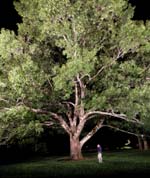 Kristen Richards Tanglewood's new Linde Center for Music and Learning is fronted by a majestic 100-year-old red oak tree.  Robert Benson Photography The largest pavilion at the Linde Center is Studio E, which features a retractable glass wall. 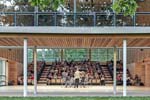 Robert Benson Photography Studio E with the glass wall open. 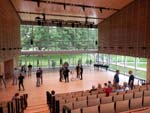 Kristen Richards Setting up for rehearsal in Studio E. 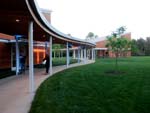 Kristen Richards A serpentine walkway connects the Volpe Family Studio and the Gordon Family Studio.  Robert Benson Photography The Gordon Family Studio with its retractable glass wall open. 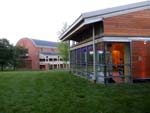 Kristen Richards The Volpe Family Studio with Seiji Ozawa Hall in the background. 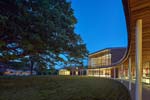 Robert Benson Photography The Linde Center at dusk.  Robert Benson Photography Cindy’s Café, with the glass-enclosed walkway to the left that leads to Studio E. 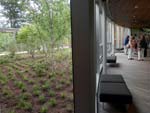 Kristen Richards A demure Zen-like birch grove courtyard garden is taking root outside the glass-enclosed walkway. 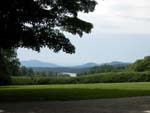 Kristen Richards The view!  William Rawn Associates Architects Tanglewood site with the Linde Center shown in red; the gray fan-shaped structure in the center is the Shed, the 5,700-seat main performance space. |
© 2019 ArchNewsNow.com